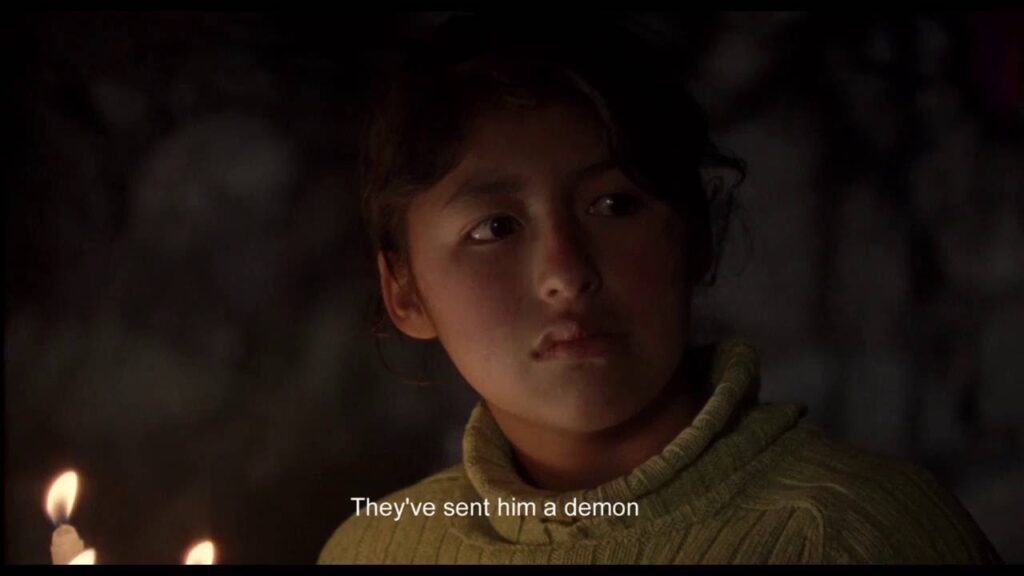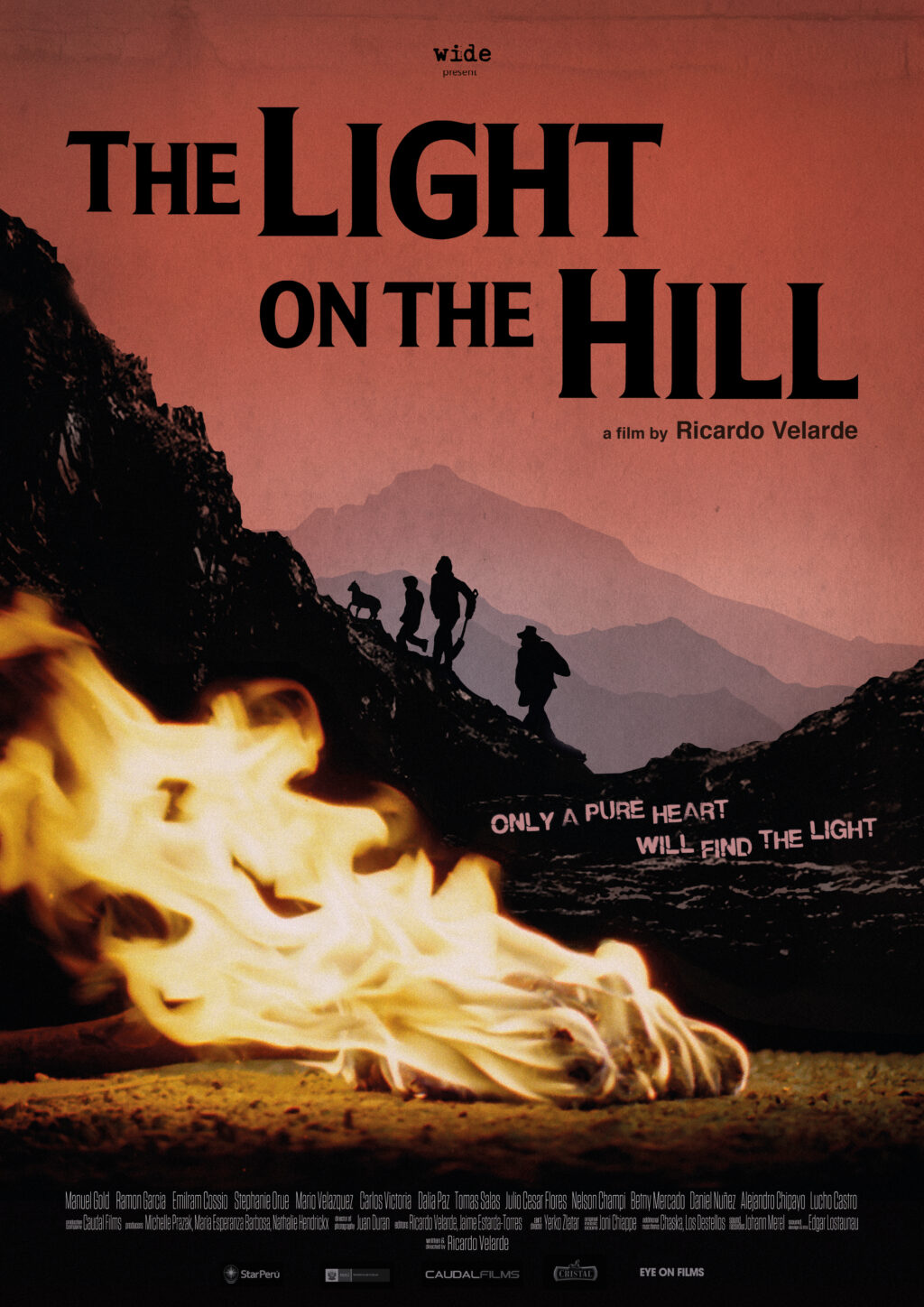‘The Light on the Hill’: The Lingering Effects of Colonization [Horror En Español]

As I dig deeper into my journey of Latin American and Spanish films, Peru has been off my radar for far too long. Although it’s not as familiar with the majority of Western audiences, the films emerging from Peru should be just as iconic as Mexico’s and Argentina’s film industry. The integration of breathtaking cinematography of the Peruvian Andes Mountains with Indigenous lifestyles is impressive. With his 2016 film, The Light on the Hill, director Ricardo Velarde blends these two elements to create a mystery thriller surrounding greed, exploitation, and the lingering effects of colonialism.
The film follows two metal head coroners, Jefferson (Manuel Gold) and Chino (Emilran Cossío), as they try to unravel the mystery behind the death of a mountain shepherd named José Cardenas (Julio César Flores). As they catch wind of the possibility of “tapados”—treasure left by the Inca Empire during the Spanish Conquest. Jefferson and Chino come up with a plan to search for the gold all while evading a confrontation between Officer Padilla (Ramón García), a rogue police officer, and Belizario (Mario Velázquez), a corrupt landowner.
Western Influences
The Light on the Hill appears on IMDB’s list of Peruvian horror films. But, in an interview with Catarsis Cultural, Velarde explicitly states the titular film is not a horror film but a mystery thriller. While this is true, the marketing of this misclassification follows suit of typical Hollywood horror films. I believe this is because the film still follows certain genre tropes.
For example, when Jeff speculates on José’s death, Velardes uses a looming atmosphere. He pans the camera between a dead llama and José clinging on to life while an invisible force suffocates him. The rest of the film uses sequences of menacing close-ups such as the father of the mourning widow Hortencia (Dalia Paz) mentioning Peruvian myths and legends regarding witchcraft and the Devil. The horror lens continues when we meet Jeff and Chino who are from the major Peruvian city, Lima. As they continue their work in the coroner’s lab, the camera presents the viewer with grisly images of a woman’s corpse and knife meeting dead flesh akin to The Autopsy of Jane Doe.
Also Read: Bacurau (2019): Dystopian Art Imitating Real Life Horrors [Horror En Español]
The Western influences don’t stop with the American horror lens. As shown before in this column, Bacurau uses a Panasonic lens to recreate the ambiance of a Western. The Light on the Hill uses the aesthetic of American exploitation films during the peak of the 1970s. Velarde shot the film with a 70 mm camera. Matching this with the dry Peruvian landscape of the Andes Mountains and colorful Indigenous culture, The Light on the Hill feels like a product that would have aired alongside other films in American grindhouses and drive-ins.

The film also follows certain tropes of organized crime films. Gangsters are obsessed with turf and are willing to go to extremes to retrieve it and an aggressive police officer doesn’t abide by anyone’s rules. All of these influences make it seem like the film may be a part of Export Cinema, a term coined by writer and filmmaker Daniel Rojas Anaya. While those films exploit the hardships of the Peruvian Indigenous community to reach Western audiences, The Light on the Hill executes the opposite by depicting Indigenous exploitation using Western influences.
The Lingering Effects of Colonialism
As the mystery of the film dissipates and the genre transitions to a thriller, the theme of greed overtakes the narrative. About halfway through the film Jeff and Chino discover the cause of José’s death. The invisible assailant is an odor of built-up arsenic gas called beneath the mountains caused by the buried gold. Their greedy instincts emerge and Jeff begins to freely manipulate the Indigenous people of the village echoing the actions of past conquerors. He begins with Hortencia by using her husband’s death as a reason to get close to the unknown to them buried gold and retrieve information about the land.
It’s important to note that Velarde displays Jeff, a white-passing Peruvian, as obnoxious with a superiority complex. When getting out late from work, Jeff bangs on the home of a restaurant owner because he misses his chance to eat. He starts to scream at the top of his lungs with no remorse to the working class and the time of night. After no response, Jeff leaves angry while Chino, who has the same skin complexion as the Indigenous population, feels for the sleeping workers and leaves hungry. In multiple instances, Jeff states his distaste for the village and its people, especially Officer Padilla. With scenes like this, it’s hard to believe Jeff has any sense of respect for the Indigenous community of Marcapata. This is why he is so willing to manipulate the people for his selfish needs.
Also Read: ‘Macario’: Mexico’s Intimacy with Death [Horror En Español]
As aforementioned, the film does enter organized crime tropes with the introduction of the character Belizario. While Jeff is off on his selfish voyage, his story is more reluctant with the colonist mindset. Belizario’s on the other hand is more evident. He has only one goal in mind: to reclaim the land he believes is owed to him. His constant harassment towards Hortencia showcases his dismissal of the Indigenous population for his personal gain. Belizario is also shown as feeling more dominant towards them. He states how he has many people within the local government who owe him favors. This is just another example of how Belizario feels he has the rural village in the palm of his hands. He continues his conquest for wanted land with no shame of his actions towards the Indigenous people around him.

While the film doesn’t depict the Peruvian Indigenous population being physically beaten and oppressed, Jeff’s and Belizario’s antics of subtle racism by taking advantage of these people showcase the lasting effects of colonialism. This coincides with scholar Christina Nelson’s work titled ‘The Effects of Neocolonialism on Indigenous Peruvians’. In it, Nelson mentions how this demographic has been the most vulnerable since the arrival of the Europeans. It started with the conquest and leads through modern times with their exploitation including the clear division between Spanish-Peruvians and Indigenous groups up through national levels. This is exactly the kind of divide Velarde depicts with Jeff and Belizario’s demeanor and actions.
Also Read: ‘Plaga Zombie’: The Pioneers in Contemporary Argentinian Horror Cinema
In between these exploitive deeds, Velarde takes his time to appreciate the Indigenous lifestyle while displaying the mixture of Spanish colonization. A prime example is José’s funeral which Velarde presents through his horror lens filled with grim shots. During the funeral, we see the integration of ominous Catholic imagery and the spoken language of Aymara, a blend of modern beliefs and traditional practices. The viewers don’t just get exploited Indigenous culture for the sake of worldwide reach like those within Exported Cinema. Instead, Velarde shows the dangers of continuing this colonist mindset through Jeff and Belizario’s exploitation while appreciating the culture and Indigenous peoples of Peru.
The Light on the Hill is a genre-blended film that feels distinctively Peruvian with its usage of history, myths, and setting. While it is misclassified as a part of the horror genre, it’s still a film that can be cherished by genre fans. I’m glad to have come across this multi-layered film that still manages to include thrills while speaking upon a problem Peruvians and other Latin American Indigenous groups struggle with today.
Categorized:Editorials Horror En Espanol News
